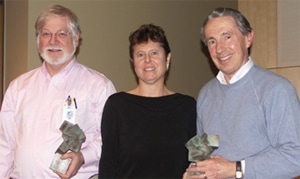Agilent Labs Awards 2007 Barney Oliver Prize for Innovation
|
|
December 20, 2007
Agilent Laboratories awarded the 2007 Barney Oliver Prize for Innovation December 14 to John Eidson and Bruce Hamilton. The prize recognizes outstanding technical contributions at Agilent Laboratories that demonstrate creativity, innovation, technical depth, synergy, and business value that lead to a useful technical or scientific result. John and Bruce developed a high-precision time synchronization protocol that enables the use of Ethernet for real-time applications in test and measurement, telecommunications and industrial automation. Their work resulted in an international standard, known as IEEE 1588, that provides for precision timing in networks. LXI is the LAN-based successor to GPIB. The LXI standard goes beyond GPIB to provide additional capabilities that reduce the time it takes to set up, configure and debug test systems. LXI also helps integrators leverage the time and effort already invested in system software and architecture. The standard is managed by the LXI Consortium, a not-for-profit corporation comprised of leading test and measure-ment companies. The group's goals are to develop, support and promote the LXI standard. LXI's flexible packaging, high-speed I/O, and prolific use of LAN address a broad range of commercial, industrial, aerospace and military applications. The LXI Consortium announced at the AUTOTESCON 2007 tradeshow September 13 that “a survey of its member manufacturers shows that annual sales of LXI-equipped test and measurement equipment now exceeds $200 million (US). This represents the fastest ramp-up in sales of any communications standard in the history of the test industry, according to LXI Consortium officials.” Just two years ago the LXI Standard was introduced at this same tradeshow. “In addition, the Consortium announced that there are more than 419 LXI-equipped products, including spectrum analyzers, digital multimeters, signal generators, signal analyzers, power supplies, power analyzers, waveform generators, oscilloscopes, and digitizers from such notable manufacturers as Agilent, Xantrex/Elgar, Keithley Instruments, Pickering Interfaces, Rohde & Schwarz, and VXI Technology.” Mesures magazine, a Paris-based monthly that reports on instrumentation and industrial automation, highlighted Agilent's 6000L Series low-profile oscilloscopes in its 12th annual Palmars Technologique awards. These oscilloscopes are based on the LAN eXtensions for Instrumentation (LXI) standard and are optimized for use in test systems. About the Barney Oliver Prize Barney then joined Bell Telephone Laboratories where he quickly established a reputation for brilliant, creative insights and clever inventions. In 1952, Bill Hewlett and David Packard persuaded Barney, whom they had known since their student days, to join their fledgling operation as director of research. In 1957 he became vice president of Research and Development, and in 1966, he established Hewlett-Packard Laboratories, which he directed until his retirement in 1981. During his career Barney was awarded 60 patents and authored 71 papers that reflect a remarkable breadth and depth of thought, ideas, and actions spanning physics, mathematics, electronic and electrical engineering, education, and social issues. He was active in the IEEE and served as its president in 1965. Barney had a lifelong interest in astronomy, and in particular the use of radio telescopes for the search for extraterrestrial intelligence. Between 1982 and 1993 he was the chief engineer of the SETI (Search for Extraterrestrial Intelligence) Institute and member of the SETI board of trustees. Barney received many awards. In 1986 President Reagan awarded Barney the National Medal of Science for “translating the most profound discoveries of physical and communication science into the electronic, radio, and computer systems which have improved our culture and enriched the lives of all Americans.” In 1997 the SETI Institute established the Bernard M. Oliver Chair, and in 2004 Barney was inducted posthumously into the National Inventors Hall of Fame. Among his academic honors were the Halley Lectureship on Astronomy and Terrestial Magnetism of Oxford University (1984). |
